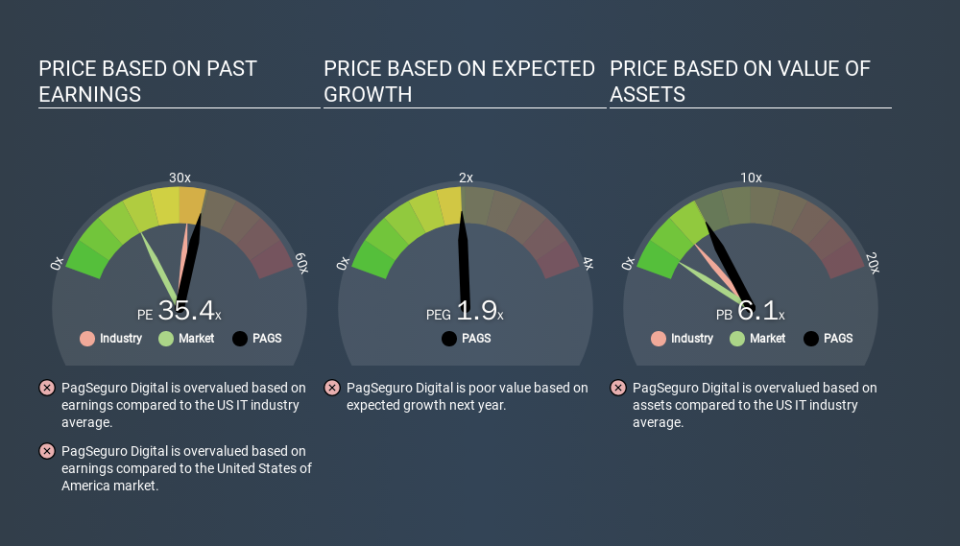Despite Its High P/E Ratio, Is PagSeguro Digital Ltd. (NYSE:PAGS) Still Undervalued?

The goal of this article is to teach you how to use price to earnings ratios (P/E ratios). We'll apply a basic P/E ratio analysis to PagSeguro Digital Ltd.'s (NYSE:PAGS), to help you decide if the stock is worth further research. PagSeguro Digital has a price to earnings ratio of 35.42, based on the last twelve months. That is equivalent to an earnings yield of about 2.8%.
See our latest analysis for PagSeguro Digital
How Do You Calculate PagSeguro Digital's P/E Ratio?
The formula for P/E is:
Price to Earnings Ratio = Share Price (in reporting currency) ÷ Earnings per Share (EPS)
Or for PagSeguro Digital:
P/E of 35.42 = BRL139.98 (Note: this is the share price in the reporting currency, namely, BRL ) ÷ BRL3.95 (Based on the trailing twelve months to September 2019.)
Is A High Price-to-Earnings Ratio Good?
A higher P/E ratio means that buyers have to pay a higher price for each BRL1 the company has earned over the last year. All else being equal, it's better to pay a low price -- but as Warren Buffett said, 'It's far better to buy a wonderful company at a fair price than a fair company at a wonderful price'.
How Does PagSeguro Digital's P/E Ratio Compare To Its Peers?
The P/E ratio essentially measures market expectations of a company. The image below shows that PagSeguro Digital has a higher P/E than the average (32.2) P/E for companies in the it industry.
Its relatively high P/E ratio indicates that PagSeguro Digital shareholders think it will perform better than other companies in its industry classification. Shareholders are clearly optimistic, but the future is always uncertain. So investors should delve deeper. I like to check if company insiders have been buying or selling.
How Growth Rates Impact P/E Ratios
Probably the most important factor in determining what P/E a company trades on is the earnings growth. If earnings are growing quickly, then the 'E' in the equation will increase faster than it would otherwise. And in that case, the P/E ratio itself will drop rather quickly. So while a stock may look expensive based on past earnings, it could be cheap based on future earnings.
Notably, PagSeguro Digital grew EPS by a whopping 49% in the last year. And its annual EPS growth rate over 5 years is 109%. I'd therefore be a little surprised if its P/E ratio was not relatively high.
Don't Forget: The P/E Does Not Account For Debt or Bank Deposits
It's important to note that the P/E ratio considers the market capitalization, not the enterprise value. In other words, it does not consider any debt or cash that the company may have on the balance sheet. Theoretically, a business can improve its earnings (and produce a lower P/E in the future) by investing in growth. That means taking on debt (or spending its cash).
Such expenditure might be good or bad, in the long term, but the point here is that the balance sheet is not reflected by this ratio.
So What Does PagSeguro Digital's Balance Sheet Tell Us?
PagSeguro Digital has net cash of R$2.1b. That should lead to a higher P/E than if it did have debt, because its strong balance sheets gives it more options.
The Verdict On PagSeguro Digital's P/E Ratio
PagSeguro Digital trades on a P/E ratio of 35.4, which is above its market average of 18.4. Its net cash position is the cherry on top of its superb EPS growth. To us, this is the sort of company that we would expect to carry an above average price tag (relative to earnings).
Investors should be looking to buy stocks that the market is wrong about. If the reality for a company is better than it expects, you can make money by buying and holding for the long term. So this free report on the analyst consensus forecasts could help you make a master move on this stock.
Of course you might be able to find a better stock than PagSeguro Digital. So you may wish to see this free collection of other companies that have grown earnings strongly.
If you spot an error that warrants correction, please contact the editor at editorial-team@simplywallst.com. This article by Simply Wall St is general in nature. It does not constitute a recommendation to buy or sell any stock, and does not take account of your objectives, or your financial situation. Simply Wall St has no position in the stocks mentioned.
We aim to bring you long-term focused research analysis driven by fundamental data. Note that our analysis may not factor in the latest price-sensitive company announcements or qualitative material. Thank you for reading.

